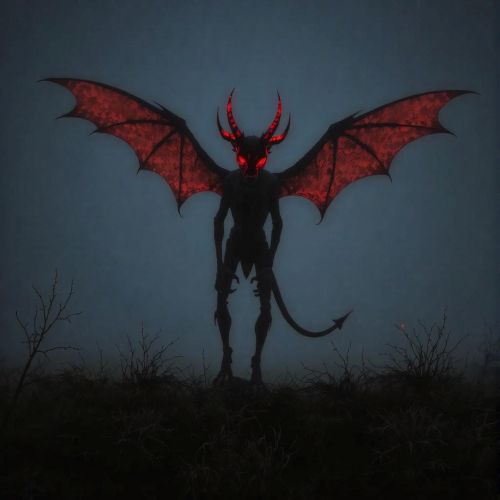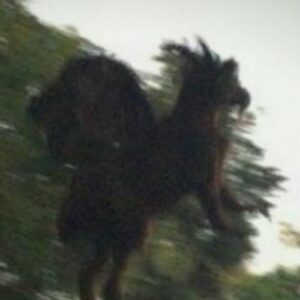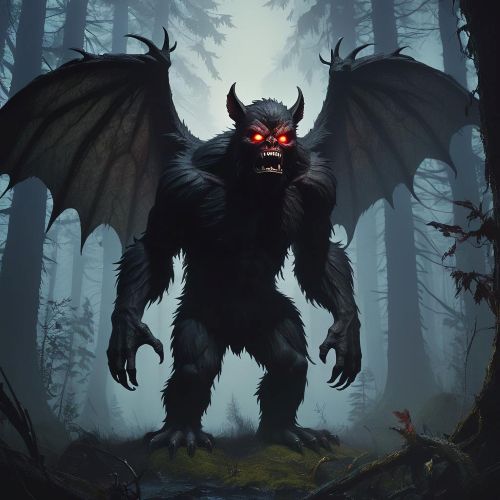
Jersey Devil : The Cursed Child
| Description | |
|---|---|
| Origin | United States of America |
| Classification | Cryptid |
| Demeanour | Evil |
| Habitat | Forest |
| Status | Not Proved |

Introduction
The Jersey Devil remains one of America’s most chilling and persistent legends, rooted in the mist-shrouded Pine Barrens of New Jersey. A strange blend of folklore, superstition, and regional identity, this cryptid has stirred the imagination of generations. Said to be born of a cursed child in the 1700s, it is a tale passed down through whispers in the woods, fueled by sightings and strange occurrences that resist rational explanation. For over 250 years, the Jersey Devil has lurked in shadowy forests and taken flight in the minds of curious seekers and terrified witnesses.
Physical Attributes
Eyewitness descriptions often paint a grotesque hybrid unlike any known animal. It is frequently reported as a bipedal, winged creature with the head of a horse or goat, leathery wings similar to a bat, and a serpentine or forked tail. Its limbs end in hooves and claws, adding to its menacing silhouette. A hallmark of its presence is its unearthly scream—shrill, blood-curdling, and capable of freezing listeners in their tracks. Accounts vary in detail, but most agree on its roughly human-sized stature and glowing red eyes that pierce through the darkness. Some suggest it moves with an awkward gait, almost kangaroo-like, making it all the more unnatural.
First Sighting/Reporting
The earliest known origin of the legend dates back to 1735 in Leeds Point, when a local woman—forever remembered as Mother Leeds—reportedly cursed her 13th child in a moment of despair. After giving birth, she allegedly watched in horror as the infant morphed into a demonic creature, sprouted wings, and escaped up the chimney into the woods. While it’s impossible to separate truth from embellishment, this tale became the genesis of an enduring myth.
In later centuries, notable figures like Joseph Bonaparte, brother of Napoleon, claimed to have seen the creature while hunting in the early 1800s. The most explosive surge of activity came in January 1909, when mass sightings were reported across New Jersey and nearby states. Witnesses described the creature attacking trolleys, flying over cities, and leaving bizarre tracks in the snow. Panic ensued, prompting police investigations, media coverage, and even temporary school closures.
Other Names
While today it’s commonly known as the Jersey Devil, the creature was originally referred to as the “Leeds Devil,” tying it to the local family at the heart of the original tale. The Leeds name wasn’t just folklore—it came with historical baggage. The Leeds family had been involved in controversial publishing and were labeled heretics by local Quakers, which likely fed into the myth’s evolution. Over time, the name “Jersey Devil” gained prominence, cemented by the 1909 media frenzy that spread the legend far beyond the Pine Barrens.
Interestingly, before the European settlers coined these names, Indigenous tribes had their own beliefs tied to the Pine Barrens, often associating the land with dark or spiritual forces. Some oral traditions refer to winged beasts or forest spirits, suggesting that the idea of something unnatural lurking there may predate colonial times.
Modus Operandi
The Jersey Devil is typically a creature of the night, often encountered in brief, spine-chilling glimpses. It rarely stays still, darting between trees or flying low under the cover of darkness. Its shriek is often heard before it is seen, and this unnatural cry has been reported as resembling a tortured woman, a whistling wind, or even the roar of an angry beast.
It has a reputation for disturbing livestock—draining blood, mutilating bodies, or leaving them missing entirely. Farmers throughout the 18th and 19th centuries blamed it for missing chickens, dead cows, and trampled crops. While some of these incidents could have more natural explanations, the consistency with which they are associated with the Jersey Devil keeps the fear alive.
Hunters, thrill-seekers, and cryptid investigators have tried tracking it for generations, yet the creature has always managed to vanish without a trace. This elusive nature only deepens the mystery and strengthens its mythic status.
Pop Culture References
The Jersey Devil’s reach extends far beyond campfire stories. It has become a fixture in horror movies, novels, and television shows, often depicted as a lurking terror or misunderstood beast. “The X-Files” dedicated an entire episode to the creature, helping introduce it to a wider audience in the 1990s. Other series like Supernatural and American Dragon: Jake Long have also included nods to the legend.
Even sports have embraced the lore—the NHL team New Jersey Devils adopted the name in 1982, branding themselves with one of the most iconic symbols of local mythology. Theme parks like Six Flags Great Adventure have used the creature as inspiration for roller coasters and haunted attractions, blending legend with entertainment.
Books and academic studies have attempted to peel back the layers of the myth. Works like The Secret History of the Jersey Devil delve into the creature’s historical context and its cultural resonance. Folklorists and skeptics alike see the Devil not just as a monster, but as a symbol of New Jersey’s rugged identity and the uneasy relationship between wilderness and civilization.
Current Status
Despite technological advances, the Jersey Devil remains uncaptured and unverified. No physical evidence—no clear photos, no carcass, no DNA—has ever been recovered. Yet the legend refuses to fade. Modern cryptid hunters still conduct night expeditions into the Pine Barrens, armed with night-vision cameras and sound equipment, hoping to be the first to capture proof.
Skeptics argue the creature is nothing more than folklore, a regional boogeyman kept alive by media, misidentified animals, and overactive imaginations. Still, believers hold that something strange exists in those woods—something not yet explained by science or dismissed by ridicule.
Source
New Jersey Pinelands Commission. (n.d.). Jersey Devil. State of New Jersey. Retrieved June 4, 2025, from https://www.nj.gov/pinelands/home/jersey-devil/
Pinelands Preservation Alliance. (n.d.). The Jersey Devil and Folklore. Retrieved June 4, 2025, from https://pinelandsalliance.org/the-jersey-devil/
Wikipedia contributors. (2024). Jersey Devil. Wikipedia. https://en.wikipedia.org/wiki/Jersey_Devil
Atlantic County Library. (n.d.). Jersey Devil – Fact or Fiction? Retrieved June 4, 2025, from https://www.atlanticcountylibrary.org/jersey-devil-fact-fiction/
The Historical Society of New Jersey. (n.d.). The Jersey Devil in Myth and History. Retrieved June 4, 2025, from https://hsnj.org/jersey-devil-history/
Cryptid Hunters. (n.d.). The Jersey Devil Cryptid: Appearance, Behavior, and Habitat. Retrieved June 4, 2025, from https://cryptidhunters.com/jersey-devil/
Mythika. (n.d.). Jersey Devil Alternate Names: Leeds Devil. Retrieved June 4, 2025, from https://mythika.com/jersey-devil-alternate-names-leeds-devil/
Rutgers University Libraries. (n.d.). Running With The Jersey Devil. Rutgers University. Retrieved June 4, 2025, from https://libraries.rutgers.edu/jersey-devil








